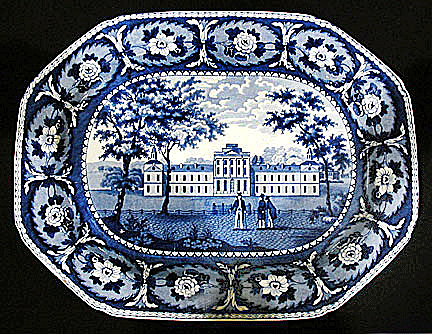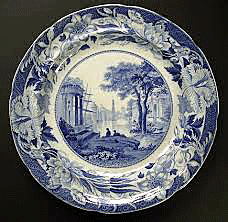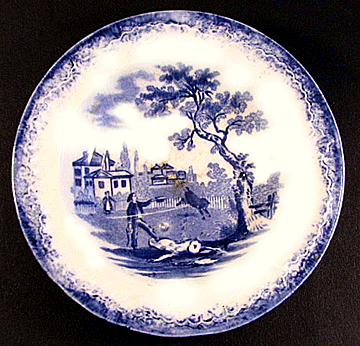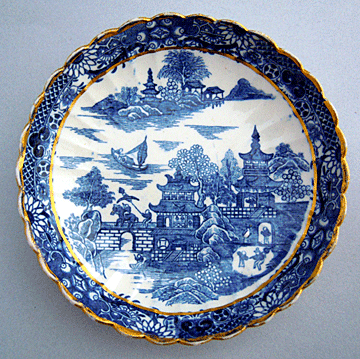|
The Origins of Blue and White Ware
by
Bob Brooke
 In
the mid-18th century, wealthier British and colonial housewives began
using blue and white porcelain ware. Over time, it has become one of the
leading favorites of china collectors. In
the mid-18th century, wealthier British and colonial housewives began
using blue and white porcelain ware. Over time, it has become one of the
leading favorites of china collectors.
The Chinese first produced porcelain painted in under-glaze blue during
the 14th century, but it wasn’t until 300 years later in 1604 that a
Dutch ship captured a Portuguese carrack, the Catharina, returning from
a voyage to China loaded with 100,000 pieces of blue and white
porcelains. The Dutch East India Company auctioned them off in
Amsterdam, which prompted all the East India companies to begin trading
in porcelains.
 These
first imports, called Kraak porselyns by the Dutch, were usually
thinly potted and sand from the saggars in which they were fired was
often not properly cleaned off of the deep- footed rims. This, together
with the watered down, deep purplish blue used in painting them, made
them a distinctive group. The name Kraak, rather than referring
to the crackled glaze on some pieces, came from the type of Portuguese
trading ship, the carrack. These
first imports, called Kraak porselyns by the Dutch, were usually
thinly potted and sand from the saggars in which they were fired was
often not properly cleaned off of the deep- footed rims. This, together
with the watered down, deep purplish blue used in painting them, made
them a distinctive group. The name Kraak, rather than referring
to the crackled glaze on some pieces, came from the type of Portuguese
trading ship, the carrack.
While certainly used at the Chinese Court, these wares found success not
only in the Near Eastern Courts of Egypt and Persia, but also in the
ports of India, Burma and the Malay Archipelago.
 The
Chinese traded with Turkey before the 15th century, and even then
Europeans considered blue and white ware comparatively cheap and more
satisfactory for daily use than any European ware available at that
time. Diluted blue wares made for everyday use, unlike the deeper ones
made for the Emperor, had a calligraphic style that formalized flowering
branch and animal subjects, as well as Imperial five-clawed dragons
rushing through cloud scrolls above great waves breaking onto rocks, to
grasp at the flaming pearls at which they feed. The
Chinese traded with Turkey before the 15th century, and even then
Europeans considered blue and white ware comparatively cheap and more
satisfactory for daily use than any European ware available at that
time. Diluted blue wares made for everyday use, unlike the deeper ones
made for the Emperor, had a calligraphic style that formalized flowering
branch and animal subjects, as well as Imperial five-clawed dragons
rushing through cloud scrolls above great waves breaking onto rocks, to
grasp at the flaming pearls at which they feed.
Try as they could, European potters couldn’t reproduce the Chinese
technique, but the state potteries of Germany, France and Italy did
produce beautiful imitations. In northern Europe, the closest in
appearance was tin-glazed earthenware, believed to have been developed
first in England but soon established so firmly in the Netherlands that
it became known as Delft ware, after the town where much of it was made.
The British Compete With the Chinese
 When
the English factories began to manufacture porcelain in the late 1740s,
they immediately tried to meet the demand for under-glaze blue china.
Their ideal was to imitate the Chinese ware as closely as possible and
their fine, translucent delicate porcelain filled the bill. With few
exceptions, blue and white porcelain was made for everyday use. And it
was a good seller and cheap to produce. When
the English factories began to manufacture porcelain in the late 1740s,
they immediately tried to meet the demand for under-glaze blue china.
Their ideal was to imitate the Chinese ware as closely as possible and
their fine, translucent delicate porcelain filled the bill. With few
exceptions, blue and white porcelain was made for everyday use. And it
was a good seller and cheap to produce.
The Bow Company of London began making
blue and white porcelain in 1747, but, although it was able to make flat
wares, the demand for dinnerware of plain shape was far greater than it
could supply. Thus it imported chinaware to fill this need, as well as
for the increasing need for inexpensive teaware, catering to the
popularity of tea drinking.
The Chinese were the first to use cobalt blue as a painted decoration on
porcelain. After a potter shaped the bowl or vase and it had dried, he
painted the design with cobalt oxide--called an underglaze—before
he applied the glaze. Only one firing was necessary since cobalt oxide
resists the change in heat needed to melt the glaze, allowing the
decoration to be applied before the glaze was fired.

Nearly all the underglaze blue decoration
came from the Chinese but the effect produced by the English potters was
unintentionally different. While much of the symbolism and subtlety of
the Chinese designs was missing, their designs, while truly English in
style, were completely Chinese in inspiration.
While the painted designs show a Chinese influence, the potters looked
elsewhere for the inspiration for their shapes. Some came from
contemporary English pottery, others from European factories. But the
main inspiration came from English silver designs--sauce boats, cream
boats, mugs and coffee pots. Of the 18 or so factories that produced
blue and white porcelain in England, 15 made soft-paste and 3 made hard
paste.
 The
process of transfer printing on china originated about 1751, when John
Brooks, an Irish-born engraver, attempted to patent an invention for
printing decoration on china. The first printing on ceramics occurred at
Worcester in 1761, when some jugs bearing a portrait of King Frederick
the Great of Prussia, with the initials of the engraver, Robert Hancock,
and the date 1757 were produced. Soon after, Worcester and other
factories began making large quantities of blue-printed ware imitating
the Chinese imports. The Shropshire factory of Caughley, operated by
Thomas Turner, followed its lead 14 years later. The
process of transfer printing on china originated about 1751, when John
Brooks, an Irish-born engraver, attempted to patent an invention for
printing decoration on china. The first printing on ceramics occurred at
Worcester in 1761, when some jugs bearing a portrait of King Frederick
the Great of Prussia, with the initials of the engraver, Robert Hancock,
and the date 1757 were produced. Soon after, Worcester and other
factories began making large quantities of blue-printed ware imitating
the Chinese imports. The Shropshire factory of Caughley, operated by
Thomas Turner, followed its lead 14 years later.
But it took another nine years for the transfer-printing process to be
perfected for use on earthenware, since the more porous surface of
earthenware made it more difficult to transfer designs effectively.
Also, this product was much cheaper to produce than porcelain and a
process had to be found that would increase production at a lower cost.
 By
1780, Josiah Wedgwood had introduced a whitened version of his creamware
and before long found that his new china, called “Pearl ware,” formed an
excellent background for blue printing. By
1780, Josiah Wedgwood had introduced a whitened version of his creamware
and before long found that his new china, called “Pearl ware,” formed an
excellent background for blue printing.
As the spending power of the public increased in the 19th century,
blue-printed pottery became immensely popular and nearly all the
factories in Staffordshire made it in quantity. Also in 1784, Parliament
reduced the heavy tax on tea, thus stimulating the demand for teaware.
At the same time, England was at war with France. To raise funds, the
government imposed a duty on silver, leading to a greater demand for
pottery teapots. At the same time, imports of chinaware began to decline
until, in 1799, the East India Company of London had none for sale and
import duties on porcelain increased 109 percent.
Blue and White Staffordshire Appears
 North
Straffordshire potters led by Josiah Spode introduced blue printing into
Stoke, England, in the mid-1780s. Although several other potters tried
the process earlier, it was Spode who perfected it. Skilled craftsmen
from the Caughley factory joined him in 1783 to help produce blue prints
of exceptional quality. North
Straffordshire potters led by Josiah Spode introduced blue printing into
Stoke, England, in the mid-1780s. Although several other potters tried
the process earlier, it was Spode who perfected it. Skilled craftsmen
from the Caughley factory joined him in 1783 to help produce blue prints
of exceptional quality.
Those owning Chinese dish sets found it hard to obtain replacements or
additions and turned to Spode and Caughley, who had previously copied
the Chinese patterns on porcelain. Many other potters did likewise, as
well as created new designs with an oriental appearance. Thus blue and
white probably became popular due to its similarity to Chinese
porcelain.
North Straffordshire became a center for blue and white because of the
ample supply of coal to fuel the pottery kilns. These potteries and
others in Liverpool and Swansea produced huge volumes of blue and white
earthenwares. While some specialized in designs for the British market,
others produced designs especially for North America.
Identifying Authentic Blue and White
Ware
Beginning collectors usually can’t tell if Chinese blue and white ware
is authentic or not. Only an advanced collector who has studied the
designs and knows the shades of blue can tell the difference. While late
18th-century Nanking ware was the finest made, most of the Chinese ware
wasn’t finely done.
 First,
a collector must determine the composition of the body. Few
manufacturers of bone china produced blue and white, and fewer still
made stone china and porcelain. Second, a collector must assess the
quality. Is it finely or coarsely made, is the print smudged, how fine
is the engraving, and are there spur marks resulting from stacking on
fine wire spurs in the kiln on the face of the plate? First,
a collector must determine the composition of the body. Few
manufacturers of bone china produced blue and white, and fewer still
made stone china and porcelain. Second, a collector must assess the
quality. Is it finely or coarsely made, is the print smudged, how fine
is the engraving, and are there spur marks resulting from stacking on
fine wire spurs in the kiln on the face of the plate?
Collectors must learn to distinguish pieces of blue and white by their
decoration, glaze, paste, design and foot-ring. No amount of reading or
visits to museums can compare with the instinct, knowledge and
experience which comes with the actual handling of porcelain. Later
Chinese export ware usually bore no mark, but earlier pieces often bore
the emperor’s reign mark.
Very early prints were line-engraved and dark blue, while those after
1805 are lighter blue. Third, is the pattern a popular one. If not, try
to find a picture of it in a book from the public library. It’s possible
that the design has been recorded even if the maker is unknown.

When identifying a maker, three possibilities exist: possibly Spode—pattern
and quality are typical and it would be nice if it was from that
factory; probably Spode--this maker was known to have produced this
pattern, but this piece has certain untypical features which prevent
attribution; and attributed to Spode—a piece
with the maker’s mark has been recorded that’s identical in every
respect with the specimen.
Most of the early pieces are thickly potted and the underglaze blue is
usually remarkably bright and vivid. Floral decoration predominated,
with stylized Oriental motifs and borders, with the ware left mostly
white with touches of blue.
By the late 1750s, the pottery had become less clumsy and the blue tone
somewhat darker. At this time, powder blue decoration—called such
because the underglaze was blown or dusted onto the porcelain in powder
form, rather than painted with a brush—became a specialty at the Bow
Company. But by the early 1770s, both the quality of the porcelain and
decoration had deteriorated so much they resembled earthenware.
While the Bow factory specialized in blue and white from 1749-1775, the
Worcester factory produced the highest quality wares. Its molded tea
wares, sauce and cream boats had rococo panels delicately painted with
Chinese fishing scenes. Other shapes of this period include jugs,
rose-water bowls, tankards, and bowls. Nearly all show a green
translucency when held up to the light. By 1775, Bow transfer-printed
most of its blue and white. And although its high standards of potting
remained, all traces of the former rococo splendor had disappeared.
 The
Caughley factory in Shropshire specialized in blue and white ware from
1772-1799. The
Caughley factory in Shropshire specialized in blue and white ware from
1772-1799.
It derived most of its shapes from Worcester. No other factory produced
as many tea services. It transfer-printed much of its decoration.
However, its shapes are more sought after by collectors than its common
decoration.
The earliest surviving examples of this type of ware date from the early
1780s, among them the long-popular Willow pattern. It’s said to have
been first used by Thomas Turner at the Caughley factory. The design was
created by Turner and engraved by his apprentice, Thomas Minton, who
later established a factory of his own. Though Turner didn’t copy the
Willow pattern directly from any known Chinese design, it’s very close
in its superficial resemblance to imported Nanking ware.
 After
1770, the percentage of pieces with hand-painted decoration decreased.
Most printed designs were uninspired and artists did much of the painted
decoration without the care and individuality noticeable in the earlier
pieces. Less than half the porcelain produced during this period bears a
factory mark. From 1768 to the mid-1770s, most makers of Worcester wares
marked them with a crescent and some pieces of Caughley had their own
factory mark. No other factories marked their blue and white wares. After
1770, the percentage of pieces with hand-painted decoration decreased.
Most printed designs were uninspired and artists did much of the painted
decoration without the care and individuality noticeable in the earlier
pieces. Less than half the porcelain produced during this period bears a
factory mark. From 1768 to the mid-1770s, most makers of Worcester wares
marked them with a crescent and some pieces of Caughley had their own
factory mark. No other factories marked their blue and white wares.
While there are many reproductions of blue and white ware on the market,
ranging from the obvious to perfect which only an expert can
distinguish, it’s usually easier to tell a domestic reproduction as they
usually have flaws in the glaze and color of the cobalt.
Generally, authentic blue and white wares have become expensive.
Increasing interest has made them scarce and few pieces remain in
excellent condition.
<
Back to Antiques Archives Next Article > |
